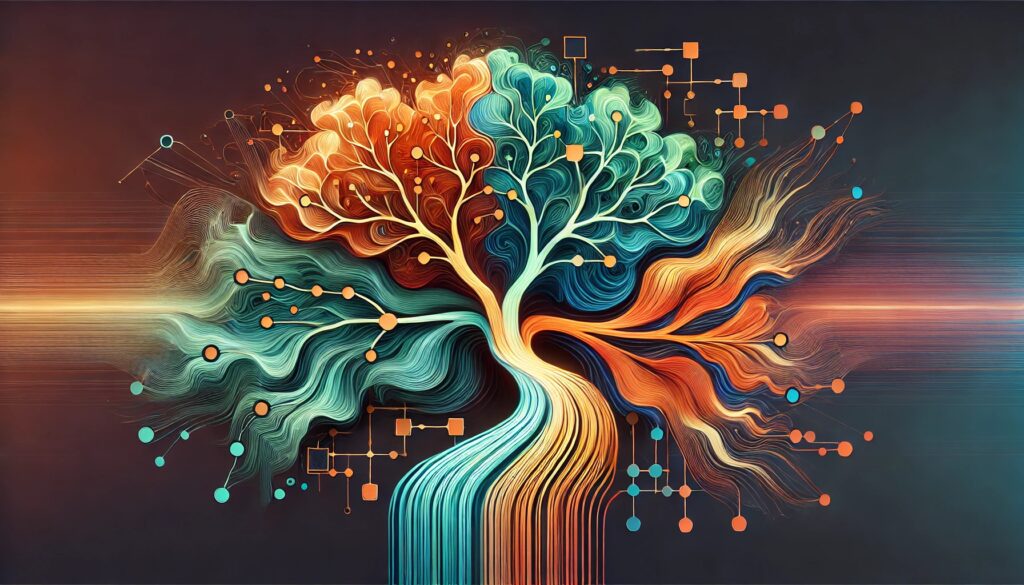
The Evolution of AI Decision-Making
AI decision-making is where things get truly interesting. Machines don’t just process data anymore—they think through complex strategies, anticipating moves before they happen.
That’s where Monte Carlo Tree Search (MCTS) and deep learning come into play, marking a new chapter in AI evolution. The hybrid approach is like watching a master chess player study each move while learning from past mistakes in real time.
Decision-making, after all, isn’t just about reacting—it’s about predicting. AI systems must navigate millions of possibilities to reach optimal outcomes. Yet, traditional approaches had limits. As AI began to tackle more intricate problems, like Go or autonomous driving, it needed a boost. Enter MCTS and deep learning: two dynamic tools, coming together to power the future of intelligent systems.
Monte Carlo Tree Search: Exploring the Basics
Monte Carlo Tree Search, or MCTS for short, might sound complex, but it’s actually quite intuitive. At its heart, MCTS is a way for AI to figure out the best move by running simulations. Think of it like trial-and-error at warp speed. Instead of calculating every possible outcome (which is impossible for big problems), it randomly simulates many scenarios and sees which ones lead to success.

The beauty of MCTS is its balance between exploration (trying new paths) and exploitation (sticking with what works). Picture a player in a maze. Instead of walking down every single corridor, they take a few steps down several and retrace the most promising routes. This method isn’t about perfection—it’s about efficiency, which is why it’s become a popular tool in game-playing AI like AlphaGo.
MCTS’s main strength is that it can handle uncertain, dynamic environments, making it adaptable. But while it’s powerful, it’s not perfect. Sometimes, it gets stuck in patterns or doesn’t see the bigger picture. That’s where deep learning enters the mix.
Understanding the Strengths of Monte Carlo Tree Search
MCTS shines because of its versatility. It doesn’t need a complete picture to make decisions; instead, it thrives on partial information. Whether it’s a game with unknown elements or real-world systems like robotics, MCTS can handle scenarios where all the details aren’t known upfront.

Another key strength is that MCTS isn’t limited to specific problems. While it was famously used in game theory, the technique can be adapted for almost any scenario where decision trees are valuable. For example, MCTS can be applied to scheduling, planning, and resource allocation problems across industries.
That said, MCTS has some drawbacks. It can be resource-intensive when scaled up for larger, more complex problems, slowing down its decision-making. And sometimes, it lacks the ability to generalize past the current scenario. Without enough guidance or prior experience, it can miss optimal pathways. But these gaps are precisely what deep learning fills.
Deep Learning: Transforming How Machines Learn
While MCTS is great at simulating outcomes, deep learning is revolutionary in teaching machines how to learn from vast amounts of data. Instead of running random simulations, deep learning algorithms can guide those simulations with knowledge gained from experience. Think of it as the difference between guessing the right move and knowing what moves usually work in similar situations.
Deep learning excels in scenarios with massive, complex data, like image recognition or natural language processing. It breaks down inputs into smaller pieces, analyzes patterns, and draws conclusions that traditional algorithms might miss. The real power here is that these systems improve as they process more information.
The Power of Neural Networks in Deep Learning
Neural networks are the backbone of deep learning. These are multi-layered structures that allow computers to recognize complex features in data. For example, when analyzing a photograph, the neural network doesn’t just “see” the picture as a whole; it recognizes shapes, colors, edges, and textures, all at different levels of abstraction. This hierarchical understanding of data lets AI grasp deeper meanings and subtle connections.
Now, when this deep understanding is applied to decision-making tasks, it gives AI the ability to recognize what might work without trying every option blindly. But there’s more to it. Neural networks also enable systems to improve continuously, adjusting based on outcomes. In essence, they’re not just smart—they’re self-improving.
By blending this with MCTS, AI gains an incredible advantage. It no longer needs to simulate every possibility because the neural network can already predict many outcomes based on patterns it has learned. The result? Faster, smarter decisions with less computational overhead.
At the core of deep learning is the neural network. These networks mimic the human brain, identifying patterns, learning from data, and applying what they’ve learned to new challenges. With deep learning, AI doesn’t just predict— it learns and adapts over time.
Why Combine Monte Carlo Tree Search with Deep Learning?
Now, you might be wondering, why bother combining these two methods—Monte Carlo Tree Search and deep learning? Well, it’s all about covering each other’s weaknesses. While MCTS is great at simulating decisions, it’s often flying blind. Without any guidance, it can get trapped in irrelevant scenarios or chase unimportant paths.

On the other hand, deep learning shines at recognizing patterns and learning from data, but it can’t make strategic decisions on its own. It’s like having all the knowledge in the world, but not knowing how to apply it to a specific, real-time situation.
When these two are fused, MCTS benefits from the foresight and intuition that deep learning provides, while deep learning gets the strategic structure MCTS offers. Instead of aimlessly simulating random outcomes, MCTS is guided by the predictions and experience embedded in the deep learning model. This creates an AI system that doesn’t just explore all options but explores the right options first.
Hybrid AI Models: The Best of Both Worlds
The marriage of MCTS and deep learning produces what we call a hybrid AI model. It’s like combining two different skill sets into one super-efficient decision-making system. While deep learning handles the intuition, MCTS manages the logical, step-by-step reasoning. This hybrid model gives AI the power to tackle problems with a level of strategy that was previously out of reach.
The hybrid approach is ideal for problems where exploration is necessary but needs to be refined with prior knowledge. For example, in games like chess or Go, you can’t feasibly check every possible move. Instead, you rely on the wisdom of the neural network to point you in the right direction, while MCTS takes care of the finer, tactical choices.

This dynamic creates a synergy that surpasses traditional methods in efficiency, speed, and problem-solving ability. When one technique falls short, the other steps in, making the system more robust.
MCTS and Deep Learning in Complex Problem-Solving
What really excites researchers and developers about combining these two methods is their potential in solving complex, real-world problems. Picture something as intricate as self-driving cars. These vehicles must make instant decisions in unpredictable environments. Should the car turn left or slow down? MCTS could simulate the possibilities, but deep learning, with its extensive data about past driving patterns, helps predict likely outcomes.

Even in finance, a hybrid model could simulate market movements (MCTS) while taking into account past data trends and behaviors (deep learning). The potential applications are almost limitless, extending to fields like healthcare, where systems must make critical decisions with incomplete information.
This hybrid system’s ability to balance uncertainty and past experience opens the door to new frontiers in problem-solving, offering more reliable and efficient outcomes across a range of industries.
Real-World Applications of the Hybrid Approach
Let’s dive into some specific real-world applications. One of the most famous examples is AlphaGo, developed by DeepMind. This groundbreaking AI used MCTS guided by a neural network to defeat some of the best human Go players in the world. Go is notoriously difficult for computers due to its immense complexity, but by combining MCTS’s simulation power with deep learning’s predictive capability, AlphaGo mastered the game far faster than previously imagined.
Outside of gaming, we see this hybrid approach in autonomous vehicles. These cars need to make thousands of micro-decisions every minute. MCTS helps simulate potential outcomes—whether to brake, accelerate, or change lanes—while deep learning provides insights based on prior driving conditions and patterns.
Another fascinating area is robotics. Robots can learn how to interact with unpredictable environments—say, a warehouse with obstacles—using the combined strengths of these models. MCTS helps explore possible routes, while deep learning offers guidance based on real-world experience.
AI Mastery in Games: From Chess to Go
The role of MCTS and deep learning in gaming cannot be overstated. AI’s first triumphs in games, such as Deep Blue’s famous victory over Garry Kasparov in chess, relied more on brute force and computing power. But when it came to a game like Go, sheer computational force wasn’t enough. That’s where the hybrid model stepped in.
By blending MCTS’s ability to simulate games with deep learning’s pattern recognition, AlphaGo was able to evaluate positions on the board in ways that previous AI systems couldn’t. It didn’t need to calculate every possible move; instead, it understood which moves were likely to succeed based on vast amounts of training data. That’s the essence of combining intuition (deep learning) with logic (MCTS).
The success of these AI systems in chess, Go, and other games represents more than just beating humans. It symbolizes the potential for AI to solve highly complex problems in real-time, where billions of possibilities exist, but only a handful are worth pursuing.
Challenges of Combining MCTS with Deep Learning
Despite the clear advantages, combining Monte Carlo Tree Search (MCTS) with deep learning isn’t without its hurdles. First and foremost, the computational cost can be substantial. Deep learning models require vast amounts of data and processing power to train, while MCTS involves running numerous simulations. When merged, this creates a model that demands both high memory usage and long training times.

Another challenge is integration. Blending these two techniques isn’t as simple as slapping one on top of the other. The real trick lies in making them work together seamlessly. For instance, when should the deep learning model guide MCTS, and when should MCTS take over and explore options on its own? Striking the right balance between exploration and guided decision-making is a constant fine-tuning process.
Moreover, overfitting can become an issue. Deep learning models, by nature, learn from data. If the training data isn’t broad enough or well-represented, the system can become biased. This means that MCTS might get bad advice from the deep learning model, leading to poor decisions. Careful curation of training data and regular adjustments are crucial to avoid these pitfalls.
Optimizing Hybrid Models: Key Strategies
To address these challenges, AI developers have started experimenting with different strategies to optimize hybrid models. One approach is parallelization. By running multiple simulations simultaneously, MCTS can speed up its decision-making process without sacrificing accuracy. This makes the system far more efficient when processing vast numbers of possibilities.
Another key strategy is the use of transfer learning in deep learning. Instead of training a neural network from scratch, AI developers can fine-tune a pre-trained model. This not only saves time but also ensures that the model already has a base of knowledge, making it more effective at guiding MCTS from the start.
Fine-tuning the way these models interact is also crucial. For example, adjusting how much weight is given to MCTS versus deep learning in specific scenarios can lead to more effective problem-solving. Developers continuously tweak parameters to make sure that neither component overpowers the other. This dynamic balancing act is what enables hybrid models to operate at peak efficiency.
The Future of AI Decision-Making with Hybrid Systems
As AI decision-making advances, the use of hybrid systems will likely become even more widespread. Industries are already exploring new ways to apply the power of MCTS and deep learning in tandem. In sectors like healthcare, for example, AI could help doctors make critical decisions based on a blend of real-time simulations and learned medical data.
In the realm of finance, where market conditions change rapidly, hybrid AI systems could revolutionize how investments are made. By simulating market scenarios while using deep learning to predict future trends, financial institutions could stay one step ahead of the competition.
Moreover, the gaming world is expected to continue benefiting from this approach, not only for entertainment purposes but also for training AI in more complex real-world scenarios. The lessons learned in virtual environments are increasingly being applied to more serious domains like military strategy, where AI-driven simulations can offer a competitive advantage in decision-making.
Potential Innovations and Ethical Considerations
As hybrid AI models become more sophisticated, there are bound to be exciting innovations, but these also come with ethical considerations. One potential breakthrough could be adaptive AI systems that learn from their environments in real-time. Imagine an autonomous drone using MCTS and deep learning to navigate changing weather patterns, or robots that learn to perform tasks better with every new interaction.
However, as AI becomes more adept at decision-making, questions of transparency and accountability arise. If an AI system makes a life-altering decision, such as in autonomous driving or healthcare, who takes responsibility if something goes wrong? Ensuring that these systems are both reliable and explainable will be critical in the future of hybrid AI.
There’s also the concern of data privacy. Deep learning models often rely on enormous amounts of data to learn effectively. When personal information is involved, it raises significant ethical questions. As we push toward more sophisticated AI, finding ways to balance innovation with ethical safeguards will be key.
How Hybrid AI Could Impact Industries Beyond Gaming
While much of the attention on MCTS and deep learning has centered on gaming, the potential applications stretch far beyond. In healthcare, for example, hybrid AI systems could be instrumental in diagnosing patients with rare diseases. With deep learning analyzing historical patient data and MCTS simulating possible treatment plans, doctors could make more informed, data-driven decisions in less time.

In manufacturing, AI systems could optimize production lines by simulating different workflow scenarios. Factories could use hybrid AI to predict potential equipment failures and adjust operations accordingly, minimizing downtime and maximizing efficiency.
Even in education, hybrid AI models could be used to personalize learning experiences for students. By simulating different learning paths and using deep learning to understand each student’s progress, AI could offer customized educational journeys that maximize learning outcomes. This level of personalization, previously unattainable on a large scale, could redefine how we think about education.
Key Takeaways: Unlocking AI’s Full Potential
By combining the strengths of Monte Carlo Tree Search (MCTS) and deep learning, we’ve unlocked a new frontier in AI. This hybrid approach not only maximizes the decision-making capabilities of AI but also improves its ability to handle complex, dynamic environments. It’s the perfect marriage of deep learning’s ability to recognize patterns and MCTS’s strategic simulation, resulting in faster, smarter decision-making processes.
Industries across the board are beginning to recognize this potential. Whether it’s mastering a game of Go, optimizing supply chains, or guiding autonomous vehicles, the ability to combine real-time simulations with predictive insights is transforming AI’s role in everyday applications. The synergy of these techniques means that AI can evolve from a tool of efficiency to a sophisticated problem-solving partner that anticipates outcomes before they unfold.
The Road Ahead: What’s Next for AI?
Looking ahead, the possibilities for hybrid AI systems are limitless. As technology evolves, we can expect to see MCTS and deep learning further integrated into systems across industries—pushing AI to new heights of innovation. Imagine AI systems that can adapt to changing environments on the fly, learning from every decision they make in real-time.
However, the future of hybrid AI is not without its challenges. Developers must continue fine-tuning these models to make them more efficient, ethical, and transparent. But the potential rewards? Enormous. With every advancement in AI decision-making, we move closer to a world where machines can solve even the most complex human problems with ease.
So, whether you’re interested in the gaming industry, self-driving cars, or healthcare innovations, one thing is clear: the future of AI lies in the hybrid model. And we’ve only just begun to scratch the surface of what’s possible.
Resources
Resources for Further Reading
- Monte Carlo Tree Search (MCTS) for AI Decision-Making
- A comprehensive overview of MCTS: Wikipedia on Monte Carlo Tree Search
- Applications of MCTS in gaming and beyond: Browne, C. B., et al. (2012). A survey of Monte Carlo tree search methods. IEEE Transactions on Computational Intelligence and AI in Games.
- Deep Learning Fundamentals
- Understanding neural networks and their applications: LeCun, Y., Bengio, Y., & Hinton, G. (2015). Deep learning. Nature, 521(7553), 436-444.
- Practical guide to neural networks: Goodfellow, I., Bengio, Y., & Courville, A. (2016). Deep Learning. MIT Press.
- Hybrid AI Models: MCTS and Deep Learning
- AlphaGo: Case study of hybrid AI: Silver, D., et al. (2016). Mastering the game of Go with deep neural networks and tree search. Nature, 529(7587), 484-489.
- Combining MCTS with deep learning: Gelly, S., & Silver, D. (2007). Combining online and offline knowledge in UCT. Proceedings of the 24th international conference on machine learning.
- Applications of Hybrid AI Systems
- The rise of AI in autonomous systems: Litman, E. (2018). AI Decision-Making in Autonomous Vehicles. IEEE Intelligent Systems, 33(3), 74-82.
- Exploring hybrid AI in healthcare: Esteva, A., et al. (2019). A guide to deep learning in healthcare. Nature Medicine, 25(1), 24-29.
- Ethical Considerations in AI
- AI accountability and transparency: Binns, R. (2018). Fairness in machine learning: Lessons from political philosophy. Proceedings of the 2020 AAAI/ACM Conference on AI, Ethics, and Society.
- Data privacy in deep learning systems: Brundage, M., et al. (2018). The malicious use of artificial intelligence: Forecasting, prevention, and mitigation. arXiv preprint arXiv:1802.07228.